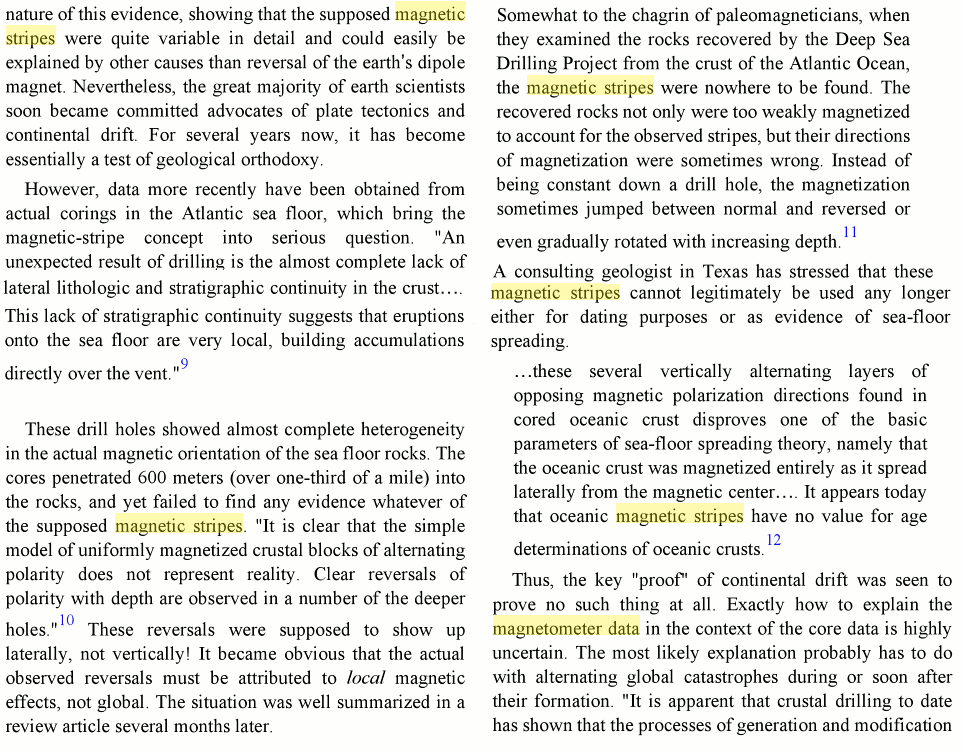© Science AdminsFrom a TB discussion:JeffreyW wrote:
The core could be a giant permanent magnet.Charles wrote:
But then the polarity of the field wouldn't flip. It might be able to migrate around, or perhaps precess. But then the magnetic field density would be constant, while the orientation would vary. What we actually see in the magnetic striping at the mid-ocean ridges is that the field drops down to nothing, and then builds back up again in the opposite polarity (i.e., the same way it does in the Sun at the peak of the sunspot cycle). The poles do not tumble — the field shuts off and then starts back up again in the opposite direction. Permanent magnets can't shut off. Besides, iron is no longer ferromagnetic above 1043 K (i.e., the Curie temperature), and even near-surface magma is hotter than that. So the only permanent magnetism would have to be in the crust. And yet the crust is rigid, so there's no way to flip the poles. So moving electric charges appear to be the only possibility.
That sounds very plausible, but so far you haven't brought Shock Dynamics into the picture. Have you? According to that the seafloor magnetic striping occurred over a period of 26 hours. Furthermore, I've read that the striping is much more chaotic on the seafloor than it appears on the ocean surfaces.
Does this mean that the Shock Dynamics event, i.e. the huge impact and the aftermath, caused disturbances in the CFDLs, which resulted in the chaotic seafloor magnetic striping?
Is there any reason not to discuss the impact scenario in the TB forum thread?
Has anyone ever read that the 'reversals' are not true reversals becasue the 'zero-line' was arbitrarily drawn and doesn't reflect a true zero-flux state? I've seen that stated in different places. If true, that would mean that there might not be any correlation between the sun's flipping and the striping effects; rather it would just record a varying magnetic field that could be explained in other ways. I've also read that the striping is not as clear-cut as is often claimed and that there are some interpretive liberties taken to try and align them with the sun's flipping.
Yes, I've read similar things, so I don't think the striping can provide much info on dating the seafloor.
Do you think you and maybe others may like to try some issue mapping at TruthMapping.com? Charles and I are checking that out and similar things. Looks like a good tool for helping clarify theories and weak and strong arguments etc.
P.S.
I meant to say would you like to do that with Mathis' theories? I'd like to myself.
"the sea floor near mid-ocean ridges revealed polarity reversals, called magnetic striping. This means that the Earth's magnetic field flips every couple hundred thousand years, and magma oozing up from the Earth's interior and solidifying takes on the polarity of the field at the time, creating a record of the inversions."
I've read that the striping only shows up at the ocean surface, but not on the seafloor itself. I read that on the seafloor field intensity is fairly chaotic and they aren't inversions, but just changes in intensity. I could be wrong in what I remember. I think the info was on Mike Fisher's site, newgeology.us
Geomagnetic Field Reversals
CC: "This means that the Earth's magnetic field flips every couple hundred thousand years"
LK: That's assuming that continental drift is an extremely slow process and that the striping conforms to field reversals.
No Magnetic Stripes
LK: See http://www.newgeology.us/presentation25.html
You mentioned correlation of a stripe or something with some fossil data. I'd be interested in seeing some of the data.
The whole process of interpreting seafloor magnetic variations detected from ocean surfaces as neat stripes of geomagnetic reversals appears to be almost total nonsense as explained in the link. As Mike says, it's better interpreted as noise, with no discernable striping pattern at all, and he explains how the noise would have occurred due to the shock dynamics event.
Ratcheting
As for tectonic ratcheting being capable of extensive movement of continents, you haven't yet answered the question of what would be the maximum distance that one ratcheting event could move a plate and the maximum number of times per year such events could occur and how ratcheting would affect striping. You seem to assume that the magnetic striping is real, but it looks fabricated to me. So you'd first have to prove that it's real.
Young Earth
Mike's logic and thoroughness is as complete for his model as yours is for CFDLs and Debye cells. So you'd have a lot of work to do to disprove Mike's conclusion. I gather that you're uncomfortable with the possibility that Earth's surface may have formed only a few thousand years ago.
Charles, the following info on magnetic striping is from this Google Book: "The Biblical Basis for Modern Science: The Revised and Updated Classic". I'm inclined to disagree with you offhand that the striping is a real feature on seafloors, or that much continental drift occurred after the initial sliding. I don't think the "drift" now is over a few cm/yr. Let's say 10 cm/yr. That times 5,000 yr = 50,000 cm = 500 m. Almost nothing. What's the maximum distance that one ratcheting event could move the North American plate? And how many ratcheting events are possible per year at a maximum?
Here's a couple pages from the Google Book.
Charles, if there's anything at all to the stripes, I thought maybe they could indicate the net field at the time of solidification, which could indicate which CFDL layer was rotating faster or slower than normal. And I think it could all have occurred in 26 hours as Mike calculated. We should be able to calculate approx. temperatures of magma during continental sliding and how quickly the magma surface would begin cooling below the curie temperature after exposure to ocean water. My guess is that it would cool that low quite quickly. I reckon a hellacious amount of steam must have been produced during the sliding and exposure to ocean waters. I guess it would have reduced sea levels and thus made flooding less of a problem.
I think it had to be a one-time event at that time. Only one impact site is centered within all of the known continental sliding.
My Impression
This is my tentative context for the above discussion. Conforming rock strata almost certainly were all laid down at the same time as shown scientifically. There are many strata in the Grand Canyon. The canyon obviously was formed when two large ancient lakes breached the "dam" that used to be where the canyon is now. The canyon formed because the strata were still soft and easy to erode because they were deposited only a few centuries earlier. Mike thinks the strata formed when an impactor formed the Moon from the Earth, leaving the trace now seen as the East Pacific Rise and part of Antarctica etc. Cardona thinks the strata were deposited from Saturn flares. In either case it seems a supercontinent formed as a result. Fossils formed as plants and animals were buried in sediment at different levels depending on the organism's density and initial location etc. The Grand Canyon formed a few hundred years later. Then the shock dynamics event occurred 5 to 14 thousand years ago.












